|
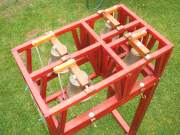
The Mini-Ring 'Minimus Four' above replicates how bells are hung in most of the countries of the world, swing-chime only with a chiming bar at one end of the headstock, the rope tied to the far end of the chiming bar.
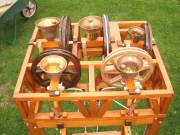
White Wheel Doubles above, this is how bells are hung in the British Isles and in a handful of other countries, the bells have a 'stay' and a 'slider' which enables them to be rung up and set in the inverted position like the bells are in the Mini-Ring above.
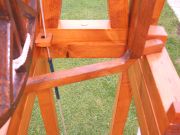
This an image of the lower part of the Number 33 Bells frame, on the left is the top part of the wheel while to the right is the stay which is resting against the curved slider which sits in the frame below the bell. The slider moves between two stops on a running block which is visible in the frame on the right.
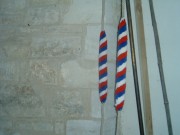
These two short sallys are for ropes which are used to ring swing-chime only bells, such technique of ringing is how bells are sounded in most of the world's church towers, like the bells which are hung in the 'Minimus Four' Mini-Ring.
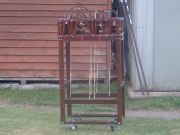
Monks Minor Mini-Ring, the ropes hang below the bells. In a church tower the ringers would stand on a platform below the ropes and the bells would not be visible from the ringing chamber as they are separated by the floor of the bell frame.
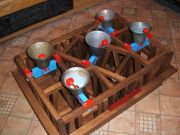
The Bergholt Doubles Mini-Ring is a copy of a very unique ring of church bells. These bells are not hung in a tower like conventional bells are but hung in a cage which is at ground level and situated in the churchyard in the village of East Bergholt.
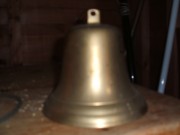
As with any tower which has a clock, the striking hammer or hammers would strike the bells 'soundbow', the wider part at the mouth of the bell.
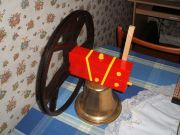
The Britannic Bell above is awaiting its frame to be built, a process which took far longer than normal as it would be painted rather than varnished.
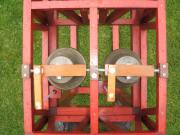
Swing-chiming bells were the order of the day before the development of wheels, stays and sliders, as seen above in the 'Minimus Four' Mini-Ring.
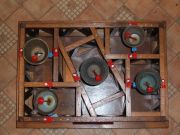
The East Bergholt bell cage in Suffolk is a unique concept on bellringing- rung from the ground with no ropes or wheels- rung totally by hand.
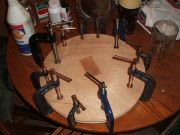
A full bell wheel made the art of 'change ringing' possible as the bellringer could control his bell which made ringing in sequence with other bells easier. With chiming bars, the bell could only be swing chimed and not always fully controlled so complex methods could not be rung.
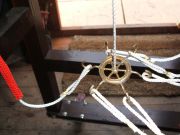
A rope pully as featured on the Mini-Ring models except Minimus Four- as swing chime only bells don't set in the 'raised' position so the ropes don't have to be safely hauled out of reach like they do in English church towers.

'Britannic Bell' in its very early stages, the headstock has bolt holes drilled into it for the stay to be bolted on and the gudgeons to be fitted into place. With chiming bells, only one bolt hole is drilled for the chiming bar, a stay requires two holes to be drilled.
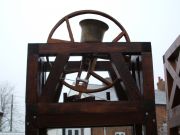
The 'Tbilisi Bell', an English style model is rung up- a feature which can only be achieved if a stay and slider are present- that is the fundamental difference between British bells which are hung for 'change ringing' while most bells hung in other countries are only for swing chiming.
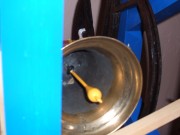
A bell from below showing the yellow painted 'clapper', a rod of steel which strikes the inside of the bell in order to make it sound. 'Muffles' are leather pouches which are strapped onto the ball of the clapper to deaden the sound, the same can be done with 'half muffles' but only half of the clapper ball is covered which will give the bell two separate tones as the clapper strikes both sides of the soundbow.
|

A BRIEF HISTORY
The technique of Church Bellringing or 'Campanology' as non-ringers call it is done in a way which is virtually unique to the British Isles, only in countries where there has been British influence such as Austrailia, United States, Canada, New Zealand are some bells rung in the unique 'British' way.
What makes the way Church Bells are rung in Britain unique is the 'Stay and Slider' concept which allows the bell to set in the inverted or raised position, as seen in the 'How A Model Is Made' page. The 'Stay' is the vertical wooden bar which is attached to the headstock at the opposite end of the wheel which engages a wooden bar hung horizontally in the framework below the bell which is known as the 'Slider'. These two bars of wood coincide with each other to allow the bells in a frame to set upside down.
In almost all other countries the bells only swing from side to side- what is known as 'Swing Chiming' where the bell is hung on a headstock with a chiming bar bolted to one end and each pull of the rope swings the bell slightly in order to sound it. Sometimes these 'swing chime' bells would have a wheel instead of a chiming bar but would not have a Stay and Slider like 'British' bells would have so would not be able to set inverted like bells hung in the British fashion do.
The 'Minimus Four' Mini Ring is a good example of how bells in most other countries are hung and rung. As with every Church or religious building which contain bells, they are hung in the church's tower and towers in Britain have large windows or 'louvers' near the top. These are basically sound exits and the bell frame would sit behind these in the tower. The louvers are designed to allow the sound of the ringing bells to escape while allowing a good flow of air to circulate around the frame keeping it free from damp. Also these louvers are positioned in a way which keeps any rain or snow from entering the tower but allows the wind to enter.

The tower of All Saints, Middle Claydon in Buckinghamshire, England. Visible near the top of the tower below the battlements are the 'louvers' or sound exits, these allow the sound of the bells out while keeping rain and damp from entering, air and wind can filter through to keep the frame from getting damp and prevent it from rotting.
With the bells hanging in the frame high up in the tower, the ringing chamber (where the ropes and ringers stand to ring the bells) is below the frame low down in the tower. Years ago many of the ringing chambers used to be at ground level but in the past couple of decades platforms have been installed so the ringing chamber is now higher up and the ringers normally have to climb a step ladder to access the ringing chamber. Although some towers do still have their ringing chamber at ground level, most have been converted with a platform- some people believe having the ringers and the bells closer together makes ringing the bells easier as more control can be obtained over the bell when its rope is shorter.
Many church towers in Britain and around the world have clocks and many of these clocks will chime and strike using one or more of the bells. A striking church clock will have a hammer or a series of hammers which strike the bells soundbow (the wider part of the bell from which its clapper strikes). This means a hammer head is always resting near or against the surface of the bell meaning that when the bell is about to be rung the hammer will get in its way. A solution for this is the practice of having a pulley system attached to the hammer which enables it to be temporarily hoisted away from the surface of the bell. When ringing has ceased and the bell is in the 'down' position the hammer can then be lowered back to its original position to carry on striking the bells soundbow. In many towers where there is a clock, there is often a warning to remind people to hoist the hammer away from the bell before ringing begins.
How Church Bellringing Evolved
Prior to the mid 17th Century, Church Bellringing in the British Isles was undertaken in the same way as Bellringing across the world is today, a bell or bells where hung in a frame for Swing Chiming only- the bell would only swing from side to side in order to sound it, a very basic way of sounding a church bell.
It wasn't until the 1600's that Church bells were being developed to swing further and enable more complex methods of ringing to be invented. This began with the development of a 'Quarter Wheel' which was just that- a device was made in the shape of a quarter of a wheel which made the bell swing that bit further than a chiming bar would allow. As the 'quarter wheel' made Bellringing that bit more complex a further development was made in the form of a 'half wheel'. The quarter wheel was developed further into a half wheel by making the existing quarter wheel twice the radius into a half wheel. This made the bell swing on its headstock further still and groups of bells where being rung with more control thus creating more of a complicated method of ringing.
After a few decades of this half wheel ringing, the ringing system was developed even further with the advent of the full bell wheel- the half wheel was turned into a full size bell wheel and each bell was retro-fitted with this new type of wheel. With all the bells having full wheels many 'methods' of Church bellringing where produced and the bells would swing almost full circle enabling better and more controlled ringing.
However, if a way of having complete control over the sounding of the bells was discovered, then the method of ringing them could become far more versatile and very complex methods of bell ringing could be invented. Sometime during this 'ringing revolution', the concept of 'setting' each bell was discovered, setting the bell in the 'up' or inverted position.
Inverting each bell was made possible by the invention of the 'Stay and Slider' mechanism. The 'Stay' was a vertical bar attached to the headstock on the opposite end of the wheel. This would coincide with a horizontal wooden bar which is attached to the frame below the bell and slides from left to right, known as the 'Slider'. Both these lengths of wood made it possible for the bells in a frame to set in the 'up' or raised position which allowed the bellringer to have complete control over his or her bell. This made ringing the bells in a particular order and the ability to change that order possible and 'methods' where written which could include up to 5000 changes on just five bells. To date, dozens of methods have been composed on bells numbering from three to twelve.
With ringing methods came the idea of the 'Peal'. This was a method of ringing in which the ringers would ring a series of methods which lasted many hours- the bells would be rung non-stop for up to twelve hours! but most peals are for around three hours and are rung for many reasons, normally in celebration for a peticular event such as a Royal Wedding or a Monarchs birthday. Also a peal could be rung to celebrate the life of a recently departed ringer or well known local person who has passed away or even to celebrate a local marriage or birth.
Peals which are rung in mourning are often 'half muffled'. A 'muffle' is a leather pouch which is tied onto the bells clapper in order to deaden its sound. 'Half muffled' ringing is when half of the bells clapper is covered with a 'half muffle'- a pouch which only covers half a bells clapper, meaning on each pull of the rope a bell will have a different tone- one its normal tone and one a muffled, quieter tone. There was also the 'Quarter Peal', a shortened version of a full peal which lasted about 45 minutes.
There is another way of ringing a bell which is known as a 'tied' bell. The bell would have a wooden tie inserted which holds the clapper still, making the bell silent - this is done when a learner is learning how to handle a bell. This can be a bit noisy so the bell is tied silent so the learner can practice away until his/hers heart is content without the risk of upsetting the locals or people who are unsympathetic towards bells and bellringing. Some bells have been vandalised to a serious extent by angry locals who live near the church and have been put off by the bells being rung.
So that is how Church Bellringing evolved - from simple 'Swing Chime' bells with simple ringing techniques to complex bell frames with highly complex ringing techniques which take weeks or even months to master.
|